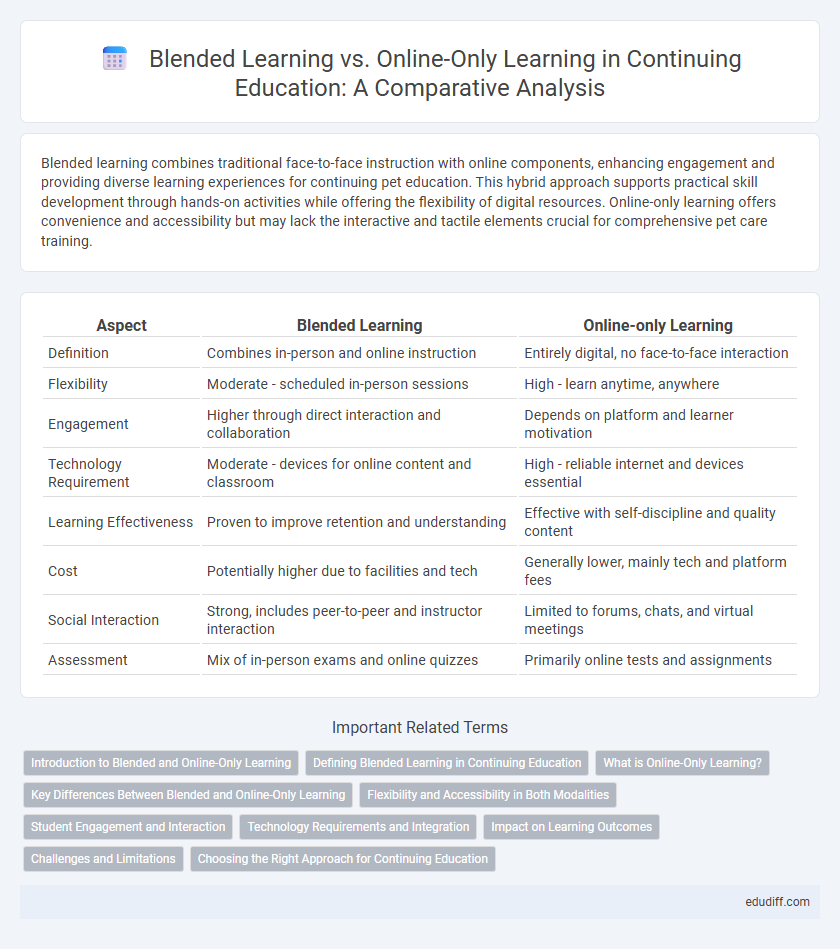Blended learning combines traditional face-to-face instruction with online components, enhancing engagement and providing diverse learning experiences for continuing pet education. This hybrid approach supports practical skill development through hands-on activities while offering the flexibility of digital resources. Online-only learning offers convenience and accessibility but may lack the interactive and tactile elements crucial for comprehensive pet care training.
Table of Comparison
| Aspect | Blended Learning | Online-only Learning |
|---|---|---|
| Definition | Combines in-person and online instruction | Entirely digital, no face-to-face interaction |
| Flexibility | Moderate - scheduled in-person sessions | High - learn anytime, anywhere |
| Engagement | Higher through direct interaction and collaboration | Depends on platform and learner motivation |
| Technology Requirement | Moderate - devices for online content and classroom | High - reliable internet and devices essential |
| Learning Effectiveness | Proven to improve retention and understanding | Effective with self-discipline and quality content |
| Cost | Potentially higher due to facilities and tech | Generally lower, mainly tech and platform fees |
| Social Interaction | Strong, includes peer-to-peer and instructor interaction | Limited to forums, chats, and virtual meetings |
| Assessment | Mix of in-person exams and online quizzes | Primarily online tests and assignments |
Introduction to Blended and Online-Only Learning
Blended learning integrates face-to-face classroom methods with digital online media, offering a flexible and interactive educational experience. Online-only learning relies solely on internet-based platforms, providing accessibility and self-paced study for diverse learners. Each approach leverages technology differently to address various learning styles and institutional goals.
Defining Blended Learning in Continuing Education
Blended learning in continuing education combines traditional face-to-face instruction with online digital resources, creating a flexible and interactive learning environment. This approach enhances learner engagement by integrating synchronous and asynchronous activities tailored to adult learners' schedules. By leveraging multimedia content and collaborative tools, blended learning supports personalized skill development and real-time feedback, which are crucial for effective professional growth.
What is Online-Only Learning?
Online-only learning is an educational approach where all instructional content and interactions occur exclusively through digital platforms without any physical classroom presence. This method leverages multimedia resources, virtual classrooms, and asynchronous assignments to provide flexible access to courses regardless of geographic location. Online-only learning environments emphasize self-paced study, digital collaboration tools, and real-time feedback to support student engagement and knowledge retention.
Key Differences Between Blended and Online-Only Learning
Blended learning integrates face-to-face instruction with online activities, offering a balanced mix that enhances engagement and personalized support, while online-only learning relies exclusively on digital platforms for content delivery and interaction. The key differences include the presence of physical classroom experiences in blended learning versus fully virtual environments in online-only learning, which impacts student motivation, social interaction, and access to immediate feedback. Additionally, blended learning often yields higher retention rates and improved practical skill development due to its hybrid nature, compared to the flexibility and scalability advantages of online-only programs.
Flexibility and Accessibility in Both Modalities
Blended learning offers increased flexibility by combining face-to-face instruction with online components, allowing students to access materials anytime while benefiting from in-person interaction. Online-only learning maximizes accessibility by enabling learners to participate from any location with internet access, eliminating geographical barriers entirely. Both modalities accommodate diverse schedules but blended learning provides structured support, whereas online-only learning demands higher self-discipline.
Student Engagement and Interaction
Blended learning significantly enhances student engagement by combining face-to-face interaction with online resources, fostering deeper collaboration and active participation compared to online-only learning. Online-only learning often struggles to replicate the dynamic peer-to-peer and instructor-student interactions that are critical for motivation and comprehension. Research shows that the hybrid approach in blended learning promotes sustained involvement, leading to improved academic outcomes and satisfaction among students.
Technology Requirements and Integration
Blended learning demands seamless integration of in-person and digital tools, requiring robust LMS platforms, reliable Wi-Fi, and multimedia devices to facilitate real-time interaction and content accessibility. Online-only learning hinges entirely on stable internet connections, cloud-based software, and adaptive learning technologies to deliver flexible, scalable educational experiences. Both models benefit from AI-driven analytics and virtual collaboration tools to enhance engagement and track student progress effectively.
Impact on Learning Outcomes
Blended learning combines face-to-face instruction with online components, leading to improved student engagement and higher retention rates compared to online-only learning. Research indicates that blended learning environments enhance critical thinking skills and practical application by integrating diverse teaching methods. Studies from institutions like the University of Central Florida report a 20% increase in student performance when blended learning models are implemented over purely online formats.
Challenges and Limitations
Blended learning faces challenges such as the need for reliable technology infrastructure and the complexity of coordinating in-person and online components effectively. Online-only learning often encounters limitations including reduced learner engagement, technical difficulties, and a lack of hands-on experience. Both modalities must address issues related to digital literacy gaps and the potential for inequitable access to educational resources.
Choosing the Right Approach for Continuing Education
Selecting the right approach for continuing education depends on individual learning preferences, career goals, and flexibility requirements. Blended learning combines face-to-face interaction with online resources, enhancing engagement and practical application, making it ideal for learners seeking hands-on experience. Online-only learning offers convenience and accessibility, suitable for professionals needing to balance education with work and personal commitments.
Blended Learning vs Online-only Learning Infographic

 edudiff.com
edudiff.com